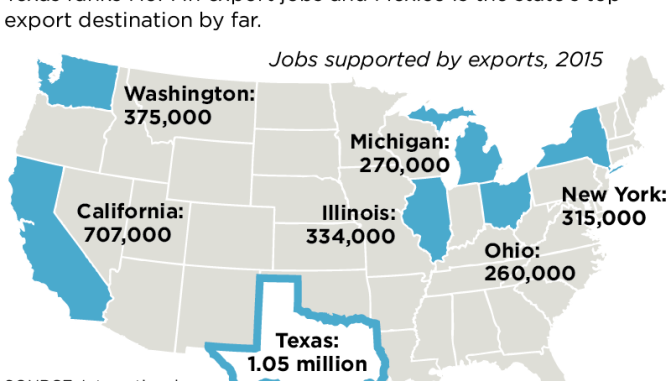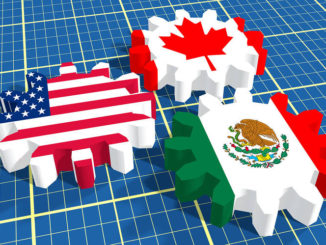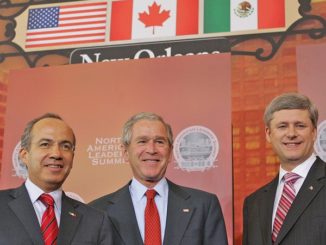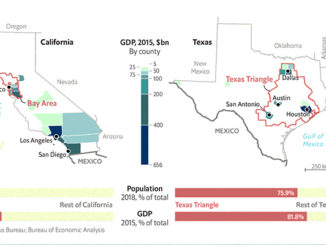
By Mitchell Schnurmanm, Dallas Morning News
The Texas economy is already pretty great, and Mexico is one of the key reasons. That’s worth remembering when President Donald Trump threatens a trade war over a border wall, as he did last week. Economically, there’s more at stake for Texas than any other state in the country. Mexico is our most important trading partner by far. In 2015, Texas exported over $92 billion worth of goods to Mexico, which was more than it exported to the next 10 countries combined. Texas imports from Mexico were almost as high, and were twice as high as from China, next on the list.
Perhaps the most impressive number: Texas exports supported over 1 million jobs in 2015, according to government estimates. That’s almost 50 percent more export jobs than in California. And that’s more jobs than in some of Texas’ major employment sectors, including construction, manufacturing, financial activities and local education. “Mexico is a huge part of the Texas success story,” said James Hollifield, a political science professor at Southern Methodist University. “The Texas economy stands to be hit hard by Trump’s policies.”
It’s still unclear how Trump will try to build a wall along the Mexican border and how it will be paid for. Last week, he floated the idea of a 20 percent tariff on Mexican imports. After it was pointed out that American consumers would pay such a border tax, administration officials said it was one of several funding possibilities.
Hollifield said it’s difficult to evaluate such potential moves, in part because the business and economic effects are secondary.
“These policies are largely driven by ideology and symbolic politics. They’re aimed at rallying people to this new nationalism,” he said.
Last week, Trump got into a Twitter debate with Mexican President Enrique Peña Nieto, who then canceled a planned trip to Washington. Nieto has said repeatedly that Mexico would not pay for a wall.
The value of the peso has fallen about 13 percent since Trump’s election victory, and Hollifield said foreign investment in Mexico is drying up. This month, Ford canceled plans for a $1.6 billion plant in Mexico after Trump railed against the move.
“Would you make huge outlays in Mexico under these circumstances?” Hollifield said.
Since the North American Free Trade Agreement, known as NAFTA, took effect in 1994, the Texas and Mexican economies have become more integrated, especially in manufacturing. Car and truck parts, for instance, move back and forth across the border, and produce more cost-effective vehicles.
Collaboration with Mexico has materially improved Texas’ global competitiveness, according to research by the Federal Reserve Bank of Dallas. That is especially evident in the energy industry and heavy machinery.
In Texas, manufacturing jobs have declined 9 percent since NAFTA, but manufacturing output has grown 4.1 percent annually since 1997, according to the Dallas Fed.
An estimated 40 percent of the content in Mexican imports originates from the U.S. That compares with about 4 percent of the U.S. content in Chinese imports.
In 2011, Mexican companies used $140 billion in U.S. intermediate goods, and U.S. industries used $111 billion worth of Mexican inputs, according to the Wilson Center’s Mexico Institute.
“This is direct evidence of joint production taking place between the United States and Mexico on a massive scale,” the center said.
Trade usually has winners and losers, and Texas communities have been on both sides. The state lost almost 50,000 jobs from NAFTA, with about half the losses in border cities. But they transformed their economies, in part by adopting training and education programs and having more workers move into higher-paying service sectors, according to a 2016 report by Jesus Cañas of the Dallas Fed.
Unemployment rates declined in El Paso, Laredo, McAllen and Brownsville. And workers in those cities made gains in median income, narrowing the gap with the U.S. average.
“Border cities went on to gain far more employment than what they lost,” Cañas wrote.
From 1994 to 2015, Texas exports to Mexico grew at roughly double the rate of the U.S. Trade with all countries followed a similar trend, with Texas’ growth rate easily outpacing the national number.
What’s good for Mexico has been good for Texas. A 10 percent increase in manufacturing on the Mexican side increases employment 2.2 percent in Brownsville, 2.8 percent in El Paso, 4.6 percent in Laredo and 6.6 percent in McAllen, the Dallas Fed said.
Mexico, which accounts for over half of Texas’ immigrants, has been a big source of labor for the growing Texas economy. From 1990 to 2010, foreign workers made up over 40 percent of the workforce growth in the state, according to Dallas Fed estimates.
Mexican companies also are big investors on this side of the border. Mexican investment in the U.S. has nearly doubled since 2007, the Wilson Center said, and those businesses support 123,000 jobs nationwide.
Grupo Bimbo, for example, has over 70 bakeries and 27,000 employees in the U.S., according to the Wilson Center.
Texas politicians have generally been silent about Trump’s executive actions, but not on the border tax. Sen. John Cornyn, Lt. Gov. Dan Patrick and House Speaker Joe Straus said they have some concerns.
In August, before Trump was elected, Cornyn wrote an op-ed with the title: “In Texas, trade is not a dirty word.”
Under Trump, everybody will have to speak a lot louder than that.




